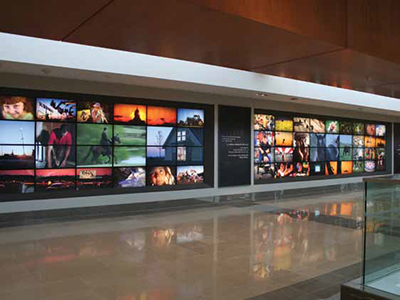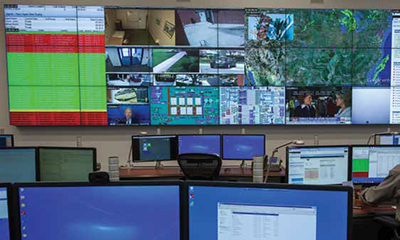Rich Media Redefines Video Wall Implementation

The potential success of even the most ambitious video wall project will lessen without an understanding of the new content and sources that dictate its design and performance.
NASA’s upgraded Payload Operations Integration Center
at the Marshall Space Flight Center in Huntsville, AL
utilizes RGB Spectrum’s OmniWall 32 Display Processor
to monitor and coordinate all experimental activities on
the International Space Station.
So what are these new content needs that are changing the command and control and digital signage space? For starters, think flexible and versatile solutions to accommodate the ever-increasing resolution of video feeds and graphics.
“In today’s information intensive environments, control system operators must be able to monitor a tremendous amount of information and collaborate with other personnel to manage data and act upon information if necessary,” said Jed Deame, vice president of marketing for RG B Spectrum. “Today’s command and control solutions must offer high-resolution video displays along with control management systems that allow administrators to define operator access to system resources and/or remote computers and equipment.”
Trends in IT technology, technology that delivers convenient access to critical information and communication, track closely with command and control content, noted John Stark, senior director of product management for Christie’s Collaborative Visual Solutions. “Virtualized computing environments such as public and private cloud infrastructure, such as VMWare, Microsoft Hyper-V and Azure, and Amazon AWS, pose a relatively new and interesting challenge to system providers that need to access and display that information in ways that the original developers of the technology did not intend.”

The University of Kentucky Health Care Center’s new “Celebrate Kentucky” multimedia wall offers patients and employees an ever-changing, complex snapshot that amplifies the center’s care for spiritual and emotional wellbeing beyond physical health. RGB Spectrum technical partner PGS Systems of Louisville, KY, designed and installed a display engine using five MediaWall 4200 video wall processors that feed thirty-two Samsung forty-two inch LCD panels. Web technologies, browsers, and protocols, are often the common link between systems, providing a standard method of access and display, he added. “Continued trends in mobile content generation and consumption bring the mobile worker into the control room and pose additional challenges to really gain operational value from operators in the field.”
It’s Rich
A daily selection of the top stories for AV integrators, resellers and consultants. Sign up below.
Due to simpler and easier creation methods, more and more rich media is becoming available. “And whether content is professionally authored or user-generated, display devices are getting more and more engaging by enabling users, and sometimes an audience, to provide their own content,” said James Chan, vice president of marketing for Mitsubishi Electric Visual Solutions America.
“In the command and control space, however, there is a faction where display data remained largely unchanged. In other segments of the market—security monitoring, for example—displays are becoming more interactive, where users are allowed to upload content they have gathered through an input point to the monitoring center. In this case, this largely expands the camera eye of the monitoring system to those integrated to the system, as well as people who have devices that are capable of generating videos.
Nonetheless, no matter what change happens with the content, displays for command and control need to be improved constantly, he added, in terms of its ability to display content of varying resolution as clearly and sharply as possible.
It’s a Sign
In the digital signage video wall market, apparently beauty is only screen deep for giving customers the wow factor.
“On the end-user side, digital signage can no longer show only vibrant and pretty content, as the attention span of a target audience is getting shorter and shorter,” Chan said. “Content now needs to be more engaging and capable of requesting and processing a call to action. For example, NFC chips can now be readily used to transmit downloadable content to smartphones, or QR codes can be strategically planned and placed to engage the customer.”
In order to impress customers, the mechanisms by which information is input and routed to video walls for display must be seamless and invisible, Deame asserted. “At RG B Spectrum, we develop products that offer parallel processing to ensure that graphics and video can be displayed in real-time. In addition, video wall processors must offer the ability to scale inputs for display without artifacting or other image disturbance.”

Christie’s American Water control room installation uses a Phoenix network-distributed open content management system and a Christie LCD flat-panel video wall display solution, giving American Water the capability to simultaneously monitor its security systems across the U.S., in one centralized location.
Good content and high-performance playback devices can help to engage audiences and improve the effectiveness of signage, resulting in longer dwell times, broader reach, and higher brand recognition, noted Richard Heslett, senior product manager for Christie’s Business Products.
“As displays continue to evolve and improve, advertisers and content creators are being presented with greater opportunities to push the boundaries of digital signage,” he said. “In order to have the desired impact, content may need to be optimized for high resolutions, unusual aspect ratios, wide color gamuts, and high frame rates. In addition, content may need to change dynamically in response to external triggers, such as RSS feeds or touchscreen events, which limits the choice of signage platforms and may require custom programming skills.”
On the provider side, digital signage needs to be upgradeable and saleable. The digital signage trend is just beginning, with a lot of growth still to come, Chan said. “Systems need to be planned in such a way that growth and expansion, with minimal impact and downtime, need to be considered when installing or setting up a video wall system.”
What They Want
In terms of video wall content viewing and sharing, customers are asking for touch integration and interactive features, Chan said. “The proliferation of tablets has given us a whole new experience on how we interact with an electronic display, and many customers have come to expect that level of interaction, such as gesturing, swiping, and touch-interactivity in other forms of displays.”
And there has been a significant growth in the demand for video wall systems that make it easy for controllers and operators to collaborate, even remotely, by accessing, displaying, and controlling shared video content, Deame noted. “At the same time, the growth of Ultra HD (4K) content and displays has resulted in higher demand for systems that offer the latest in video resolution.”
With requests for touch screens and gesture-based interactivity as major trends, customers also want a range of content for signage-oriented video walls, ranging from a single HD source that is spread across the entire wall, to custom high resolution videos in non-standard aspect ratios, Heslett explained.
In the command and control arena, Christie’s users want simple and effortless access to content, regardless of what device they are using and where they happen to be operating, Stark added. “Although the jury is out on the efficacy of mobile access in critical decision making in many situations, mobile devices continue to grow in their ability to present detailed information in an accurate, timely, and meaningful way; the trend demanding more mobile access will not stop.”
Karen Mitchell is a freelance writer living in Boulder, CO.
Content for Tomorrow
Future proofing: Every video wall needs it to accommodate future content and usage needs.
It’s very difficult for consultants and integrators to future-proof a video wall because technology is evolving so rapidly, Christie’s Richard Heslett cautioned. “However, the following tactics may help, in so far as the budget allows. First, they can strive to ensure that their entire system design, from servers to displays, can support, or be upgraded to support, the maximum available resolution, color depth, and frame rate. Second, they can select a signage platform that is extensible and accepts a wide variety of external triggers.”
The key here is flexibility and versatility within video wall processors and the control system, RGB’s Jed Deame said. “Video wall processors must be able to grow and adapt as quickly as system requirements change, which is faster than we have ever experienced. They must be able to accept a range of input signals, media, and connector types in order to meet the needs of the customer. Our products are some of the most flexible on the market. They can be configured to support all signal types and can be used in parallel to support even the largest video walls.”
The best way to future-proof your video wall, he concluded, is to choose a processor that offers the options and versatility to meet the ever-changing requirements of customers’ installations without requiring a major reconfiguration of the underlying control system.
Another tactic is to install displays that are modular and easily upgradeable and saleable.
The easiest way to avoid obsolescence is to acquire equipment that uses open standards for packaging, delivery, and display of content, Christie’s John Stark advised. “Proprietary systems should be avoided at all costs, as any proprietary system cannot have a clear path to accommodate new content delivery methods.”
Purchasing systems with modular architecture that can be modified or redeployed according to users’ future needs will help avoid the need for a “forklift” upgrade, he said. “It is always a good idea to purchase a system that is software upgradable in the field, potentially accommodating new features and content management abilities as the market demands.”
—K.M
